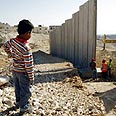
Israeli settlements an economic choice, says study
Data collected by Macro Center indicate main bulk of West Bank construction during Sharon, Olmert terms conducted west of separation fence in order to promote convergence plan. Yesha Council elements say data utterly groundless
Israel builds thousands of homes in the West Bank each year, with settlers drawn mainly by economic benefits, according to an analysis published on Tuesday by the Tel Aviv Macro Center for Political Economics and conducted by Dr. Roby Nathanson.
The United States and European Union consider the settlements illegitimate and an obstacle to peace between Israel and the Palestinians. But Israelis are attracted by their offer of affordable housing in a pleasant landscape.
"Since 2004, 6,657 new structures have been added to West Bank settlements," says the report, detailing the extent and costs of new settlement construction from 2004 to 2008.
Settlement expansion has continued since then. Israeli Prime Minister Benjamin Netanyahu last November ordered a limited halt to building for 10 months, but has resisted American and Palestinian calls for a total freeze.
In the four years to 2008, Macro says 6,657 new buildings were added to the settlements, mostly apartments in blocks.
"The cost of construction in the West Bank settlements over the last 40 years was a total of $17.4 billion," the study calculated. "The cost of buildings for housing was nearly $13.7 billion, which is 78 percent of the total."
Macro researchers said the main source of data is aerial photography of the West Bank taking in 128 Jewish settlements. It does not include Israeli building in east Jerusalem.
Security
They said far more housing units are built to the west side of Israel's West Bank separation barrier than to the east because Israel assumes those settlements beyond the fence may one day be evacuated in a land-for-peace deal with Palestinians.
"The addition of buildings on the west side was 5,900, compared to 757 on the east side," the study said, noting that "Israelis do not want to live beyond the separation barrier".
Israel began building the barrier of security fencing, ditches, military patrol roads and high concrete walls at the height of the Palestinian uprising that erupted in 2000, to keep suicide bombers reaching its cities.
The Palestinians say the barrier is intended to secure more West Bank land for Israel.
US Secretary of State Hillary Clinton told an influential Jewish-American audience on Monday "it is true that heightened security measures have reduced the number of suicide bombings".
But West Bank occupation cannot be sustained, she said. There must be a place for a Palestinian state "living side by side in peace and security".
Settlements east of the fence are often remote, hilltop villages that are home to ultra-religious Jews, who believe they must return to the Biblical lands of Judea and Samaria.
"Real estate prices on the west side of the fence are the lowest, security arrangements are better than on the east side and (offer) better access to the major cities allows settlers to work in Israel," the Macro Center report said.
"Furthermore, since most Israelis believe there is going to be an Israeli withdrawal from the east side of the barrier, they are not willing to take the risk of a future evacuation."
Responses
Members of the Peace Now organization were surprised to learn of the data and said that the settlements were and remained a first-grade national priority area. "Every day that goes by the Israeli public is paying millions of shekels in order to sustain dozens of isolated settlements and outposts that will not remain under Israeli sovereignty," a Peace Now source said.
Elements in the Yesha Council questioned the study's scientific credibility. "This is no more than a piece of propaganda penned by a leftist known for his political agenda against the settlement in Judea and Samaria."
Yesha Council Chairman Danny Dayan said that the data regarding construction costs in the West Bank are completely groundless. "The study created a false impression as though there is public expense, but the settlers paid for the houses with their hard earned money. Therefore, it is hard to take the data seriously."
Shmulik Grossman contributed to this report










